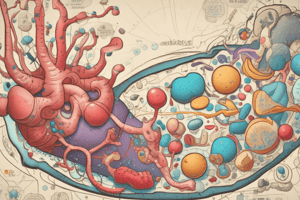Podcast
Questions and Answers
What form is created when alcohol adds to the carbonyl group of an aldehyde?
What form is created when alcohol adds to the carbonyl group of an aldehyde?
- Acetal
- Hemiketal
- Ketal
- Hemiacetal (correct)
Which monosaccharide structure is categorized as a furanose?
Which monosaccharide structure is categorized as a furanose?
- Glucose
- Fructose (correct)
- Mannose
- Galactose
Which configuration of a sugar indicates that the -OH group is below the ring on C#1?
Which configuration of a sugar indicates that the -OH group is below the ring on C#1?
- α-sugar (correct)
- D-sugar
- L-sugar
- β-sugar
What is the main reason that a six-membered ring formation is more stable in a six-carbon aldose?
What is the main reason that a six-membered ring formation is more stable in a six-carbon aldose?
What type of structure results when the hydroxyl group is part of the same molecule containing the carbonyl carbon?
What type of structure results when the hydroxyl group is part of the same molecule containing the carbonyl carbon?
What is D-Sorbitol commonly used for?
What is D-Sorbitol commonly used for?
What is formed when the aldehyde group of an aldose is oxidized under basic conditions?
What is formed when the aldehyde group of an aldose is oxidized under basic conditions?
What defines a reducing sugar?
What defines a reducing sugar?
What type of acid is produced when both ends of an aldose chain are oxidized?
What type of acid is produced when both ends of an aldose chain are oxidized?
What reaction does Benedict's reagent facilitate with reducing sugars?
What reaction does Benedict's reagent facilitate with reducing sugars?
What is the general formula for carbohydrates?
What is the general formula for carbohydrates?
How many carbon atoms are in a pentose monosaccharide?
How many carbon atoms are in a pentose monosaccharide?
What distinguishes an aldose from a ketose monosaccharide?
What distinguishes an aldose from a ketose monosaccharide?
Which term describes a carbon atom bonded to four different groups?
Which term describes a carbon atom bonded to four different groups?
What is the maximum number of carbon atoms present in the monosaccharides discussed?
What is the maximum number of carbon atoms present in the monosaccharides discussed?
How are structural isomers different from stereoisomers?
How are structural isomers different from stereoisomers?
What prefix is used to denote a monosaccharide containing 4 carbon atoms?
What prefix is used to denote a monosaccharide containing 4 carbon atoms?
Which of the following correctly describes chirality in a molecule?
Which of the following correctly describes chirality in a molecule?
Which of the following monosaccharides is found in the highest concentration in milk?
Which of the following monosaccharides is found in the highest concentration in milk?
What type of bond links the monosaccharides in sucrose?
What type of bond links the monosaccharides in sucrose?
What makes lactose a reducing sugar?
What makes lactose a reducing sugar?
Overconsumption of sucrose can lead to which of the following conditions?
Overconsumption of sucrose can lead to which of the following conditions?
What is the primary source of lactose?
What is the primary source of lactose?
Which disaccharide is the sweetest?
Which disaccharide is the sweetest?
How does invert sugar differ from sucrose in terms of sweetness?
How does invert sugar differ from sucrose in terms of sweetness?
Which of the following is NOT a characteristic of disaccharides?
Which of the following is NOT a characteristic of disaccharides?
What enzyme is responsible for breaking down lactose in the human body?
What enzyme is responsible for breaking down lactose in the human body?
What significant impact can consuming high amounts of sucrose have on diet?
What significant impact can consuming high amounts of sucrose have on diet?
What type of polysaccharide is hyaluronic acid classified as?
What type of polysaccharide is hyaluronic acid classified as?
Which of the following is NOT a function of hyaluronic acid?
Which of the following is NOT a function of hyaluronic acid?
What is the primary chemical structure of chondroitin sulfate?
What is the primary chemical structure of chondroitin sulfate?
What role does heparin play in the body?
What role does heparin play in the body?
What components make up hyaluronic acid?
What components make up hyaluronic acid?
What is the significance of chondroitin sulfate in cartilage?
What is the significance of chondroitin sulfate in cartilage?
Which of the following statements about heparin is true?
Which of the following statements about heparin is true?
What is a common application of hyaluronic acid in medicine?
What is a common application of hyaluronic acid in medicine?
Flashcards are hidden until you start studying
Study Notes
Carbohydrate Nomenclature and Structure
- Carbohydrates have the general formula CnH2Oy.
- There are four groups of carbohydrates: monosaccharides, disaccharides, polysaccharides, and oligosaccharides.
Monosaccharides
- Simple sugars that cannot be broken down further.
- General formula (CH2O)n.
- Classified based on:
- Number of carbon atoms.
- Position of the carbonyl group (-C=O).
- Chirality of the molecule.
Number of Carbon Atoms
- The name of the monosaccharide depends on the number of carbon atoms present, using a prefix to represent the number of carbons and the suffix "-ose".
- Example:
- 3 carbon atoms = Triose.
- 4 carbon atoms = Tetrose.
- 5 carbon atoms = Pentose.
- 6 carbon atoms = Hexose.
- 7 carbon atoms = Heptose.
Position of the Carbonyl Group
- Depending on the location of the carbonyl group, monosaccharides are classified as aldehydes or ketones:
- Aldose: Carbonyl group is at the end of the molecule.
- Ketose: Carbonyl group is within the molecule's structure.
Chirality of the Molecule
- A chiral (asymmetric) carbon has four different groups bonded to it.
- D- and L- prefixes are used to distinguish between isomers.
Isomerism
- Isomers are molecules with the same molecular formula but different arrangements of atoms.
- Two types of isomers:
- Structural/Constitutional: Different connectivity of atoms.
- Stereoisomers: Same connectivity, but different spatial arrangement.
Structures of Common Monosaccharides
- Glucose: Aldose found in fruits, sweet, crystalline.
- Fructose: Ketose found in sugar cane, 50% sweeter than glucose, crystalline.
- Galactose: Aldose found in milk, sweet, crystalline.
Chemical Properties of Monosaccharides
- Addition of Alcohols to Ketones and Aldehydes:
- Forms hemiacetal (half acetal) or hemiketal.
- Reaction is catalyzed by acids or bases.
- Cyclization:
- Hemiacetals/hemiketals are unstable, usually present in small amounts.
- Five-membered ring: Furanose (e.g., fructose).
- Six-membered ring: Pyranose (e.g., glucose).
- α and β anomeric forms are produced.
- Oxidation to Aldonic Acids (Reducing Sugars):
- Aldehydes are oxidized to carboxylic acids.
- Aldoses can be oxidized to aldonic acids under basic conditions.
- Reducing sugars react with oxidizing agents to form aldonic acids.
- Glucose is a reducing sugar.
- Oxidation to Uronic Acids:
- Enzyme-catalyzed oxidation of the primary alcohol at C-6 of a hexose yields a uronic acid.
- Example: Glucose → Glucuronic acid.
- Redox Reaction with Glucose:
- Glucose can be oxidized and reduced.
- Oxidation: Glucose → Gluconic acid.
- Reduction: Glucose → Sorbitol.
Reducing Sugars
- Monosaccharides with a carbonyl group that oxidizes to give a carboxylic acid.
- React with Benedict's reagent (Cu2+) to give the corresponding carboxylic acid.
- Examples: Glucose, galactose, and fructose.
Disaccharides
- Two sugars linked together by an O-glycosidic bond (ether link -O-).
- Two types of glycosidic bonds:
- 1-4 glycosidic bond.
- 1-6 glycosidic bond.
- Formed via condensation of two monosaccharide molecules.
Common Disaccharides
- Sucrose: Table sugar, obtained from sugar cane or beets, sweetest disaccharide.
- Composed of glucose and fructose.
- Non-reducing sugar because both carbonyl groups are involved in glycosidic bond formation.
- Formed from α-D-glucopyranose and β-D-fructofuranose by an α-β 1,2 glycosidic bond.
- Hydrolysis with acid or invertase yields glucose and fructose (inversion of sugar).
- Lactose: Milk sugar, found in the milk of mammals, non-fermentable.
- Composed of glucose and galactose.
- Reducing sugar due to the presence of a free carbonyl group on C#1 of the glucose ring.
- Hydrolyzed by lactase into glucose and galactose.
- Maltose: Malt sugar, produced by the hydrolysis of starch.
- Composed of two glucose molecules.
- Reducing sugar.
Biological Importance of Disaccharides
Sucrose
- Provides a quick source of energy, leading to a rapid rise in blood glucose.
- Excess intake can contribute to tooth decay and displace beneficial nutrients in the diet.
Lactose
- Used as a source of chemical energy by cells.
- Important nutrient in milk for infants.
- Individuals with lactose intolerance lack the lactase enzyme to digest lactose.
Polysaccharides
- Polymers of many monosaccharide units linked together by glycosidic bonds.
- Classified as:
- Homopolysaccharides: Composed of a single type of monosaccharide.
- Heteropolysaccharides: Composed of multiple types of monosaccharides.
Homopolysaccharides
- Starch: Storage form of glucose in plants.
- Two types: Amylose (linear) and amylopectin (branched).
- Glycogen: Storage form of glucose in animals.
- Highly branched.
- Cellulose: Structural component of plant cell walls.
- Linear polymer of β-D-glucose units.
- Indigestible by humans.
Biological Importance of Other Polysaccharides
Hyaluronic Acid
- Found in animals in tissues like the vitreous body, umbilical cord, and synovial fluid.
- Polymer of D-glucuronic acid and N-acetyl-D-glucosamine linked by β-1→3 and β-1→4 linkages.
- Hydrolyzed by hyaluronidase to D-glucuronic acid, D-glucosamine, and acetic acid.
- Promotes wound repair, scavenges free radicals, and is used in biomaterials for wound healing and plastic surgery.
Chondroitin Sulfate
- Found in cartilage and cell coats.
- Polymer of D-glucuronic acid and N-acetyl-D-galactosamine linked by β-1→3 and β-1→4 linkages.
- Hydrolyzed to D-glucuronic acid, D-galactosamine, and acetic acid.
- Important component of cartilage providing resistance to compression.
- Loss of chondroitin sulfate contributes to osteoarthritis.
- Used as a dietary supplement for osteoarthritis.
Heparin
- Present in the liver, lung, and arterial walls.
- Polymer of D-glucuronic acid and D-glucosamine-N-sulphate units linked by α-1→4 and β-1→4 linkages.
- Acts as an anticoagulant, preventing clot formation.
- Hydrolyzed to D-glucuronic acid and D-glucosamine-N-sulphate.
Biological Importance of Polysaccharides
- Starch: Provides readily available energy for plants and humans.
- Glycogen: Provides stored energy in animals.
- Cellulose: Provides structural support for plants.
- Hyaluronic acid: Plays a role in tissue repair and lubrication.
- Chondroitin sulfate: Maintains the integrity of cartilage.
- Heparin: Prevents blood clotting.
Studying That Suits You
Use AI to generate personalized quizzes and flashcards to suit your learning preferences.



